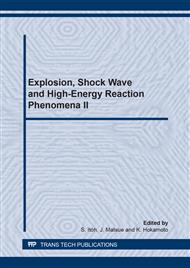[1]
I. Masumoto, K. Tamaki, M. Kojima, Electromagnetic Welding of Aluminium Tube to Aluminium or Dissimilar Metal Cores, Transactions of the Japan welding Society, 16 (1985) 110-116.
Google Scholar
[2]
H. Hokari, T. Sato, K. Kawauchi, A. Muto, Magnetic Impulse Welding of Aluminium Tube and Copper Tube with Various Core Materials, Welding International, 12 (1998) 619-626.
DOI: 10.1080/09507119809452024
Google Scholar
[3]
V. Shribman, A. Stern, Y. Livshitz, O. Gafri, Magnetic pulse welding produces high- strength aluminum welds, Welding Journal, 81 (2002) 33-37.
Google Scholar
[4]
T. Aizawa, Magnetic pressure seam welding method for aluminum sheets, Welding International, 17 (2003) 929-933.
DOI: 10.1533/wint.2003.3199
Google Scholar
[5]
T. Aizawa, M. Kashani, K. Okagawa, Application of Magnetic Pulse Welding for Aluminum Alloys and SPCC Steel Sheet Joints, Welding Journal, 86 (2007) 119s-124s.
Google Scholar
[6]
M. Watanabe, S. Kumai, K. Okagawa, T. Aizawa, In-situ Observation of Magnetic Pulse Welding Process for Similar and Dissimilar Lap Joints Using a High-Speed Video Camera, Aluminium Alloys, 2 (2008) 1992-(1997).
Google Scholar
[7]
K. J. Lee, S. Kumai, T. Arai, T. Aizawa, Interfacial microstructure and strength of steel/ aluminum alloy lap joint fabricated by magnetic pressure seam welding, Materials Science and Engineering A, 471 (2007), 95-101.
DOI: 10.1016/j.msea.2007.04.033
Google Scholar
[8]
S.D. Kore, P.P. Date, S.V. Kulkarni, Effect of process parameters on electromagnetic impact welding of aluminum sheets, International Journal of Impact Engineering, 34 (2007) 1327-1341.
DOI: 10.1016/j.ijimpeng.2006.08.006
Google Scholar
[9]
A. Berlin, T. C. Nguyen, M. j. Worswick, Y. Zhou, Metallurgical analysis of magnetic pulse welds of AZ31 magnesium alloy,Science and Technology of Welding and Joining, 16 (2011) 728-734.
DOI: 10.1179/1362171811y.0000000070
Google Scholar
[10]
Y. Zhang, S. Babu, P. Zhang, E. A. Kenik, G. S. Daehn, Microstructure characterization of magnetic pulse welded AA6061-T6 by electron backscattered diffraction, Science and Technology of Welding & Joining, 13 (2008) 467-471.
DOI: 10.1179/174329308x341915
Google Scholar
[11]
A. Kira, D. Takaenoki, H. Hamashima, R. Tomoshige, M. Fujita, K. Hokamoto, S. Itoh, Optical Observation of Extremely High Impulsive Pressure Generator Using Collision of High Velocity Metal Jets, Materials Science Forum, 465-466 (2004) 265-270.
DOI: 10.4028/www.scientific.net/msf.465-466.265
Google Scholar


